check engine FORD C MAX 2008 1.G Owner's Manual
[x] Cancel search | Manufacturer: FORD, Model Year: 2008, Model line: C MAX, Model: FORD C MAX 2008 1.GPages: 278, PDF Size: 17.5 MB
Page 144 of 278
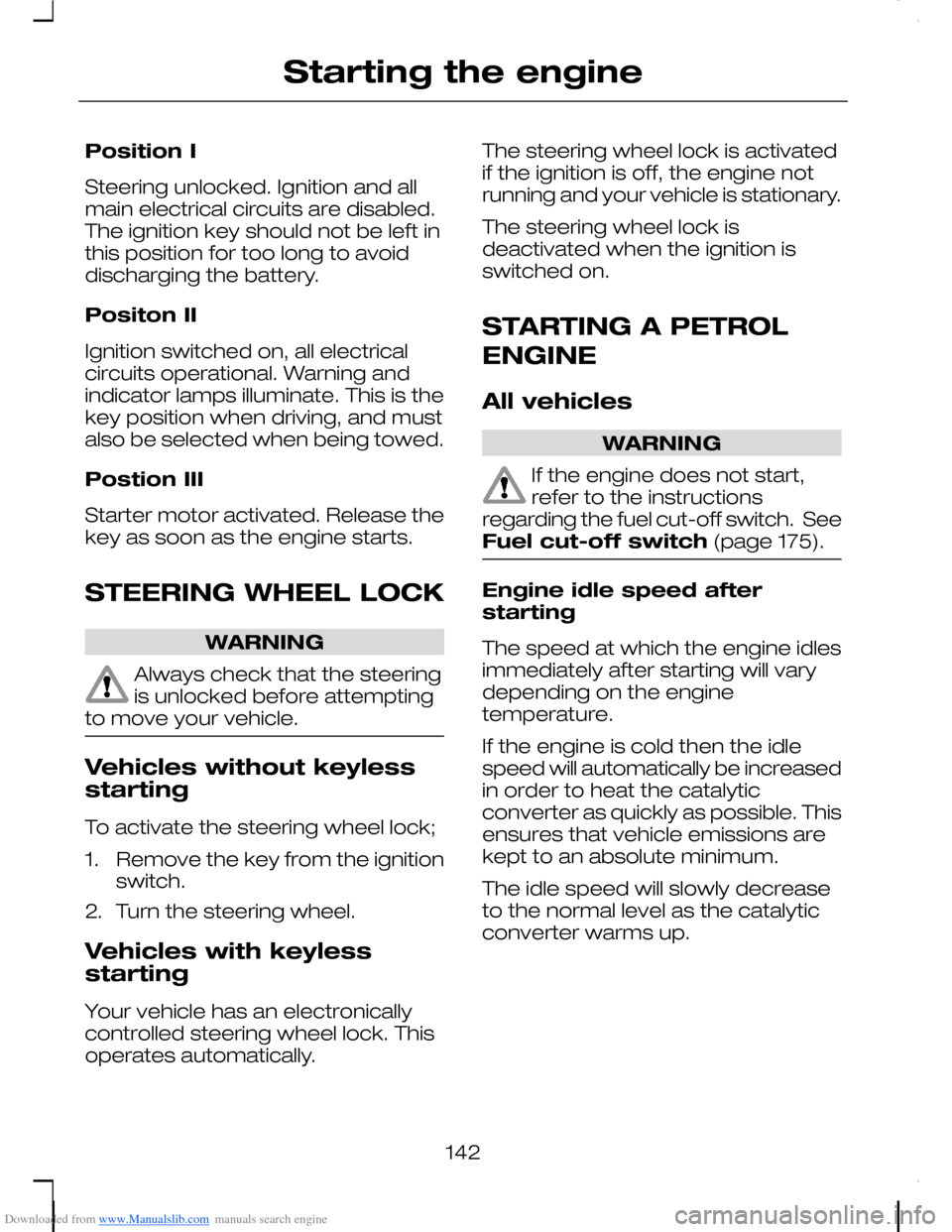
Downloaded from www.Manualslib.com manuals search engine Position I
Steering unlocked. Ignition and allmain electrical circuits are disabled.The ignition key should not be left inthis position for too long to avoiddischarging the battery.
Positon II
Ignition switched on, all electricalcircuits operational. Warning andindicator lamps illuminate. This is thekey position when driving, and mustalso be selected when being towed.
Postion III
Starter motor activated. Release thekey as soon as the engine starts.
STEERING WHEEL LOCK
WARNING
Always check that the steeringis unlocked before attemptingto move your vehicle.
Vehicles without keylessstarting
To activate the steering wheel lock;
1.Remove the key from the ignitionswitch.
2.Turn the steering wheel.
Vehicles with keylessstarting
Your vehicle has an electronicallycontrolled steering wheel lock. Thisoperates automatically.
The steering wheel lock is activatedif the ignition is off, the engine notrunning and your vehicle is stationary.
The steering wheel lock isdeactivated when the ignition isswitched on.
STARTING A PETROL
ENGINE
All vehicles
WARNING
If the engine does not start,refer to the instructionsregarding the fuel cut-off switch. SeeFuel cut-off switch (page 175).
Engine idle speed afterstarting
The speed at which the engine idlesimmediately after starting will varydepending on the enginetemperature.
If the engine is cold then the idlespeed will automatically be increasedin order to heat the catalyticconverter as quickly as possible. Thisensures that vehicle emissions arekept to an absolute minimum.
The idle speed will slowly decreaseto the normal level as the catalyticconverter warms up.
142
Starting the engine
Page 148 of 278
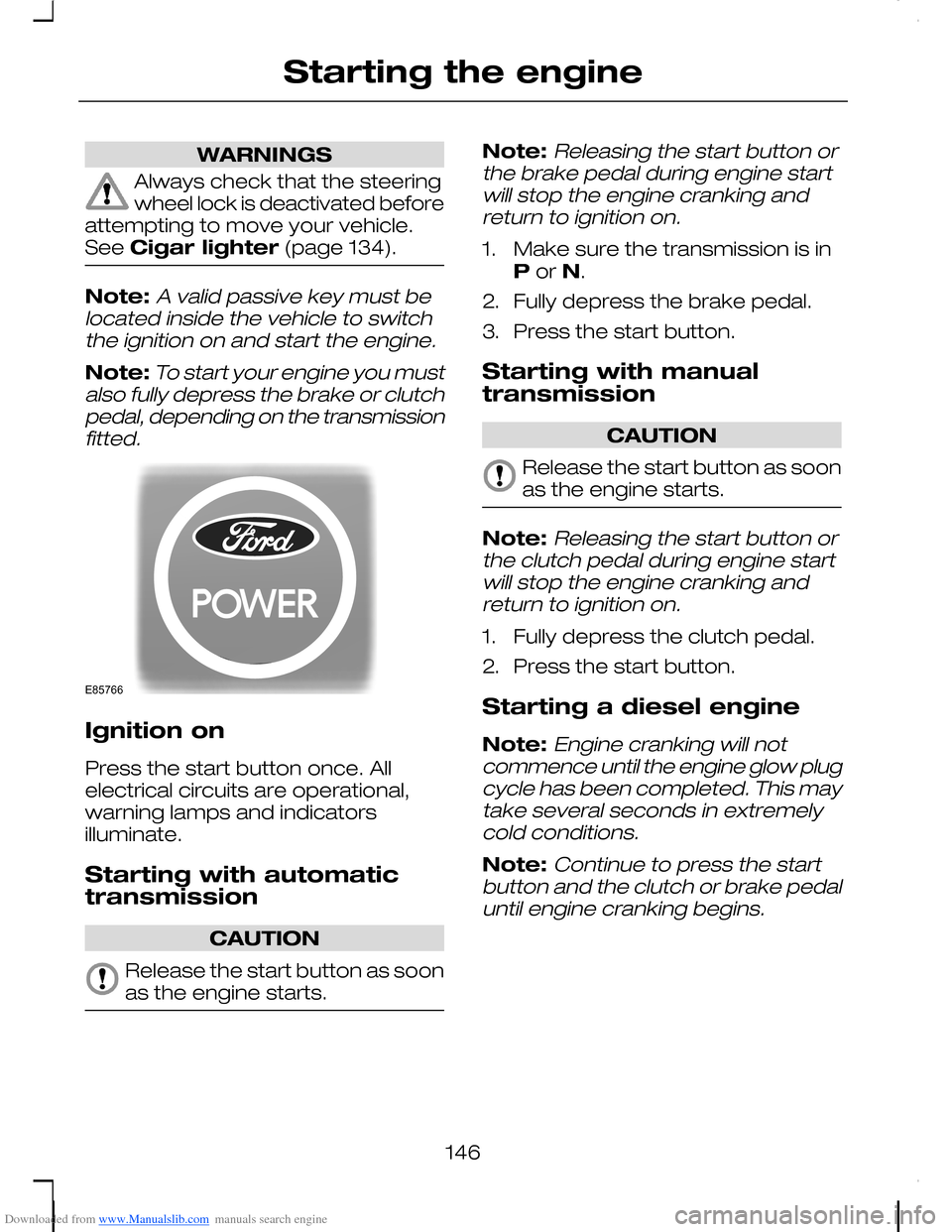
Downloaded from www.Manualslib.com manuals search engine WARNINGS
Always check that the steeringwheel lock is deactivated beforeattempting to move your vehicle.See Cigar lighter (page 134).
Note:A valid passive key must belocated inside the vehicle to switchthe ignition on and start the engine.
Note:To start your engine you mustalso fully depress the brake or clutchpedal, depending on the transmissionfitted.
Ignition on
Press the start button once. Allelectrical circuits are operational,warning lamps and indicatorsilluminate.
Starting with automatictransmission
CAUTION
Release the start button as soonas the engine starts.
Note:Releasing the start button orthe brake pedal during engine startwill stop the engine cranking andreturn to ignition on.
1.Make sure the transmission is inP or N.
2.Fully depress the brake pedal.
3.Press the start button.
Starting with manualtransmission
CAUTION
Release the start button as soonas the engine starts.
Note:Releasing the start button orthe clutch pedal during engine startwill stop the engine cranking andreturn to ignition on.
1.Fully depress the clutch pedal.
2.Press the start button.
Starting a diesel engine
Note:Engine cranking will notcommence until the engine glow plugcycle has been completed. This maytake several seconds in extremelycold conditions.
Note:Continue to press the startbutton and the clutch or brake pedaluntil engine cranking begins.
146
Starting the engineE85766
Page 153 of 278

Downloaded from www.Manualslib.com manuals search engine FUEL FILLER FLAP
Note:Central locking also locks andunlocks the fuel filler flap. See Locks(page 40).
Open the flap fully until it engages.Turn the fuel filler cap anti-clockwise.
When the filler cap is removed, ahissing noise may be heard. This isnormal and should be disregarded.
To close, turn the cap clockwise untilit clicks.
REFUELLING
CAUTION
Do not attempt to start theengine if you have filled the fueltank with the incorrect fuel. This coulddamage the engine. Have the systemchecked by a properly trainedtechnician immediately.
FUEL CONSUMPTION
The CO2 and fuel consumptionfigures are derived from laboratorytests according to EEC Directive80/1268/EEC and subsequentamendments and are carried out byall vehicle manufacturers.
They are intended as a comparisonbetween makes and models ofvehicles. They are not intended torepresent the real world fuelconsumption you may get from yourvehicle. Real world fuel consumptionis governed by many factorsincluding; driving style, high speeddriving, stop/start driving, airconditioning usage, the accessoriesfitted and towing etc.
Your Ford dealer can give you adviceon improving your fuel consumption.
151
Fuel and refuellingE78089
Page 160 of 278
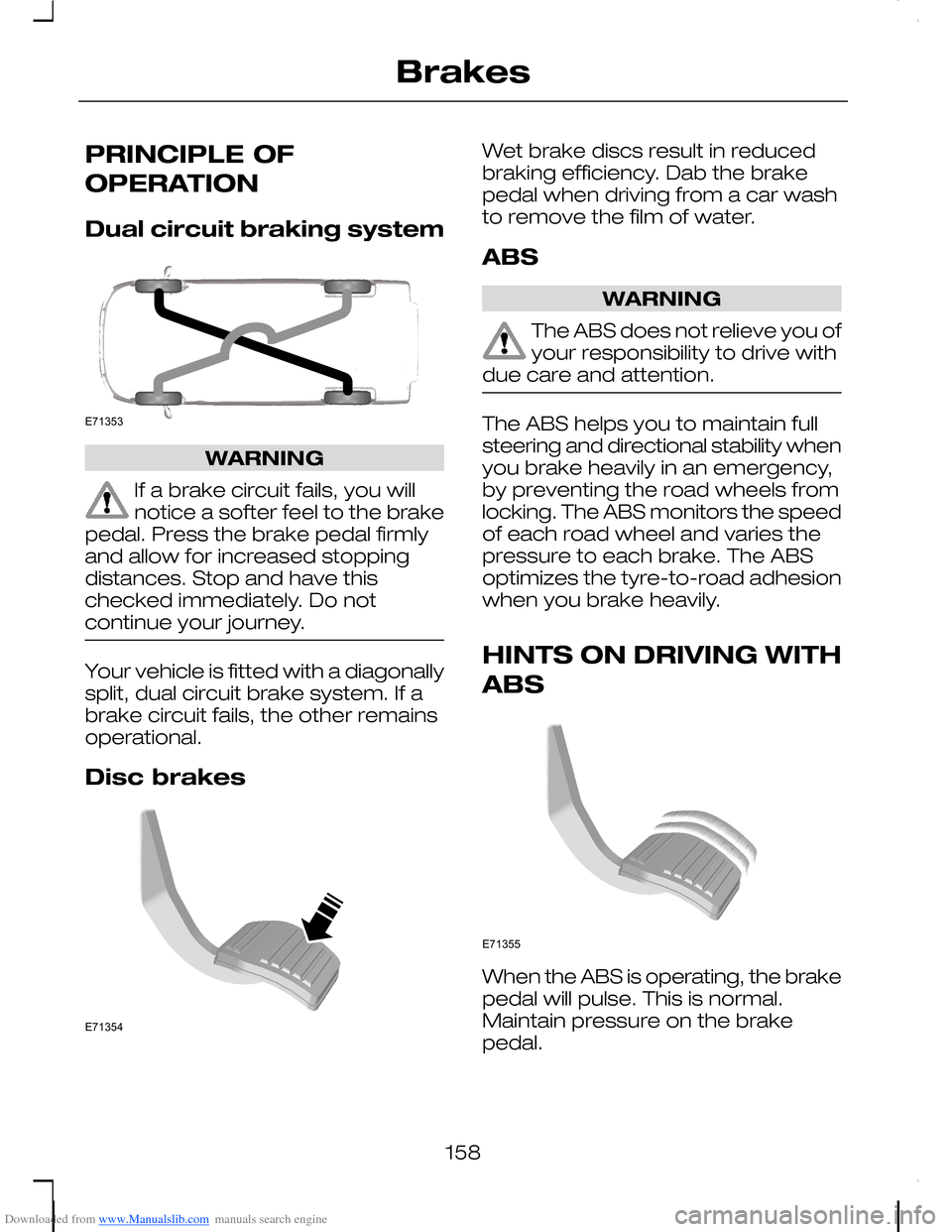
Downloaded from www.Manualslib.com manuals search engine PRINCIPLE OF
OPERATION
Dual circuit braking system
WARNING
If a brake circuit fails, you willnotice a softer feel to the brakepedal. Press the brake pedal firmlyand allow for increased stoppingdistances. Stop and have thischecked immediately. Do notcontinue your journey.
Your vehicle is fitted with a diagonallysplit, dual circuit brake system. If abrake circuit fails, the other remainsoperational.
Disc brakes
Wet brake discs result in reducedbraking efficiency. Dab the brakepedal when driving from a car washto remove the film of water.
ABS
WARNING
The ABS does not relieve you ofyour responsibility to drive withdue care and attention.
The ABS helps you to maintain fullsteering and directional stability whenyou brake heavily in an emergency,by preventing the road wheels fromlocking. The ABS monitors the speedof each road wheel and varies thepressure to each brake. The ABSoptimizes the tyre-to-road adhesionwhen you brake heavily.
HINTS ON DRIVING WITH
ABS
When the ABS is operating, the brakepedal will pulse. This is normal.Maintain pressure on the brakepedal.
158
BrakesE71353 E71354 E71355
Page 165 of 278
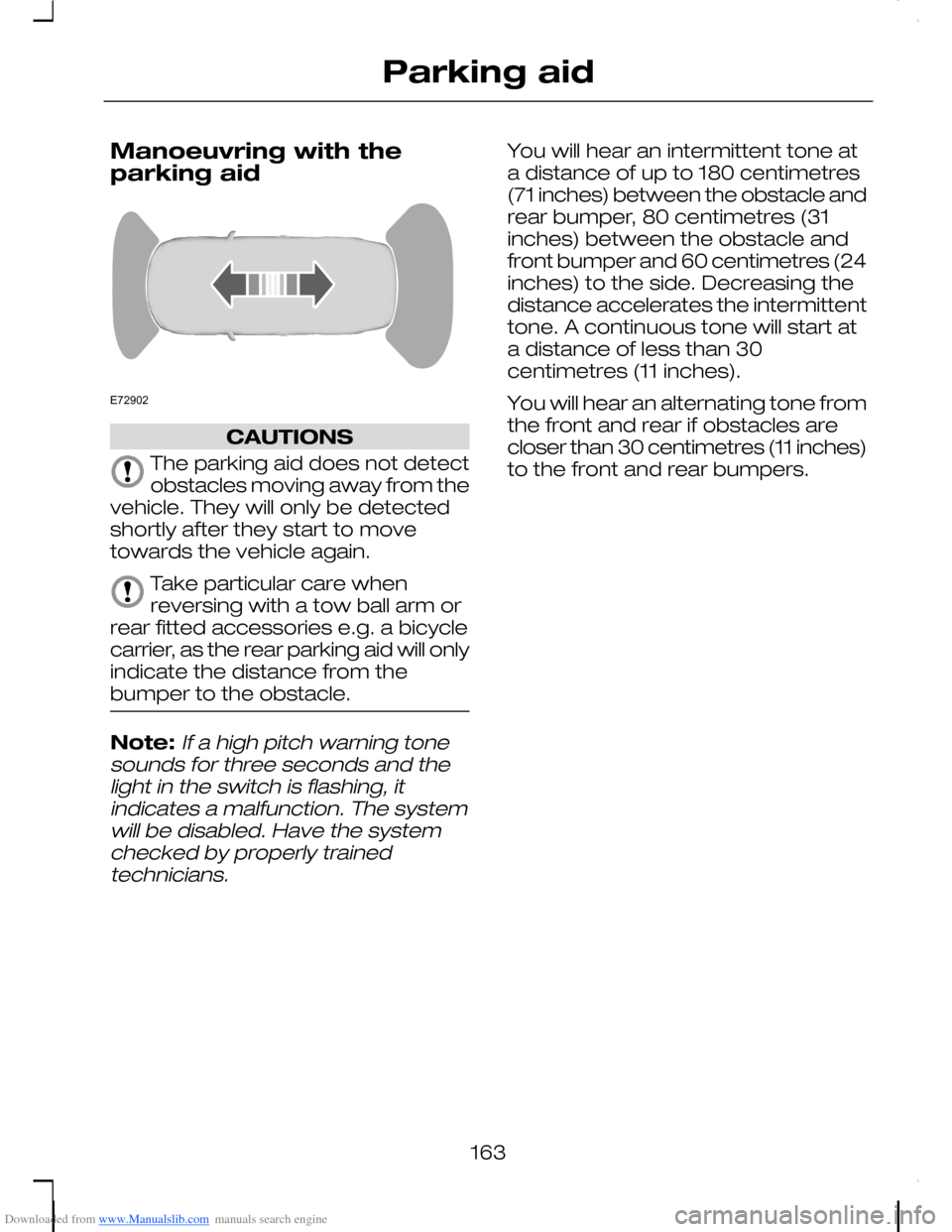
Downloaded from www.Manualslib.com manuals search engine Manoeuvring with theparking aid
CAUTIONS
The parking aid does not detectobstacles moving away from thevehicle. They will only be detectedshortly after they start to movetowards the vehicle again.
Take particular care whenreversing with a tow ball arm orrear fitted accessories e.g. a bicyclecarrier, as the rear parking aid will onlyindicate the distance from thebumper to the obstacle.
Note:If a high pitch warning tonesounds for three seconds and thelight in the switch is flashing, itindicates a malfunction. The systemwill be disabled. Have the systemchecked by properly trainedtechnicians.
You will hear an intermittent tone ata distance of up to 180 centimetres(71 inches) between the obstacle andrear bumper, 80 centimetres (31inches) between the obstacle andfront bumper and 60 centimetres (24inches) to the side. Decreasing thedistance accelerates the intermittenttone. A continuous tone will start ata distance of less than 30centimetres (11 inches).
You will hear an alternating tone fromthe front and rear if obstacles arecloser than 30 centimetres (11 inches)to the front and rear bumpers.
163
Parking aidE72902
Page 171 of 278
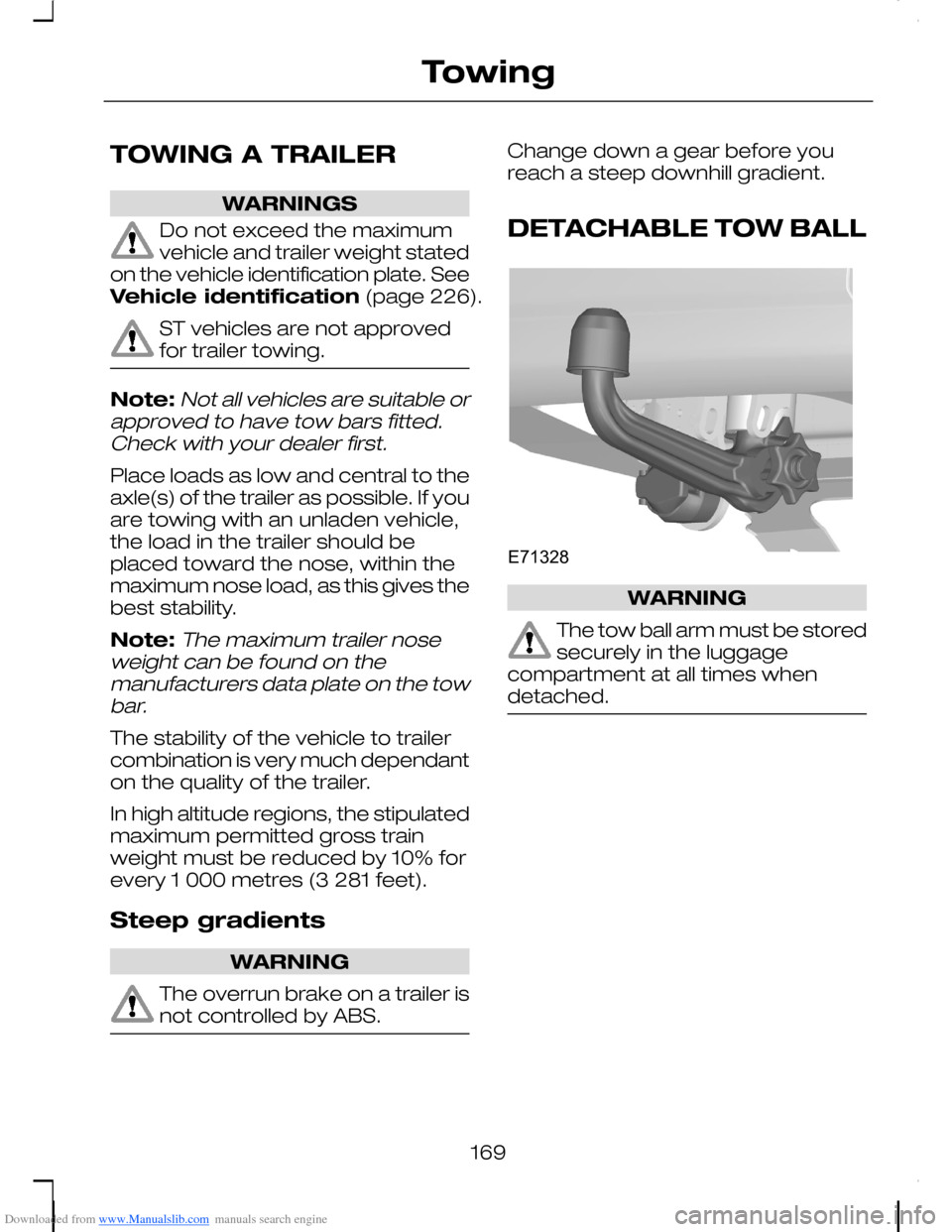
Downloaded from www.Manualslib.com manuals search engine TOWING A TRAILER
WARNINGS
Do not exceed the maximumvehicle and trailer weight statedon the vehicle identification plate. SeeVehicle identification (page 226).
ST vehicles are not approvedfor trailer towing.
Note:Not all vehicles are suitable orapproved to have tow bars fitted.Check with your dealer first.
Place loads as low and central to theaxle(s) of the trailer as possible. If youare towing with an unladen vehicle,the load in the trailer should beplaced toward the nose, within themaximum nose load, as this gives thebest stability.
Note:The maximum trailer noseweight can be found on themanufacturers data plate on the towbar.
The stability of the vehicle to trailercombination is very much dependanton the quality of the trailer.
In high altitude regions, the stipulatedmaximum permitted gross trainweight must be reduced by 10% forevery 1 000 metres (3 281 feet).
Steep gradients
WARNING
The overrun brake on a trailer isnot controlled by ABS.
Change down a gear before youreach a steep downhill gradient.
DETACHABLE TOW BALL
WARNING
The tow ball arm must be storedsecurely in the luggagecompartment at all times whendetached.
169
TowingE71328
Page 173 of 278

Downloaded from www.Manualslib.com manuals search engine 1.Insert the tow ball arm verticallyand press it upwards until itengages. Do not hold your handnear the handwheel.
2.To lock: Turn the key clockwiseand remove the key.
Insert the end of the protection capinto the keyhole.
Driving with a trailer
WARNING
If any of the below conditionscannot be met, do not use thetow bar and have it inspected by anexpert.
Before starting your journey, ensurethe tow ball arm is properly locked.Check that:
•The green mark on thehandwheel is next to the white doton the tow ball arm.
•The handwheel A is pushed inagainst the tow ball arm.
•The key B has been removed.
•Secure positioning of the towballarm. (Must remain perfectly inplace when jerked.)
Removing the tow ball arm
1.Remove the protection capcovering the keyhole. Insert thekey and turn it anticlockwise tounlock.
2.Hold the towball arm. Pull out thehandwheel and turn it clockwiseuntil it clicks and pull the towballarm downwards.
3.Remove the tow ball arm.
Release the handwheel.
When unlocked in this way, the towball arm can be reinserted at anytime.
171
TowingE71331AB 31E713322
Page 177 of 278
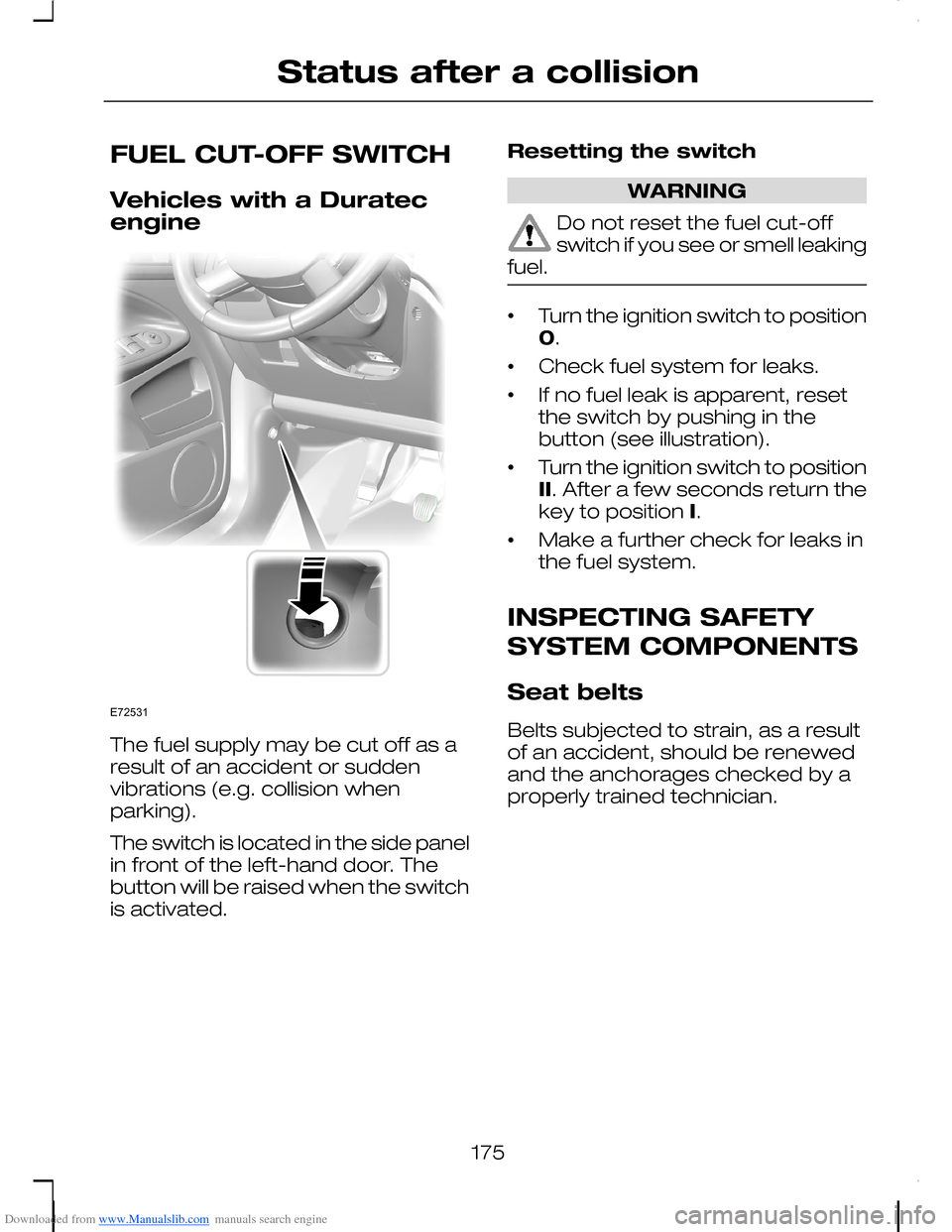
Downloaded from www.Manualslib.com manuals search engine FUEL CUT-OFF SWITCH
Vehicles with a Duratecengine
The fuel supply may be cut off as aresult of an accident or suddenvibrations (e.g. collision whenparking).
The switch is located in the side panelin front of the left-hand door. Thebutton will be raised when the switchis activated.
Resetting the switch
WARNING
Do not reset the fuel cut-offswitch if you see or smell leakingfuel.
•Turn the ignition switch to position0.
•Check fuel system for leaks.
•If no fuel leak is apparent, resetthe switch by pushing in thebutton (see illustration).
•Turn the ignition switch to positionII. After a few seconds return thekey to position I.
•Make a further check for leaks inthe fuel system.
INSPECTING SAFETY
SYSTEM COMPONENTS
Seat belts
Belts subjected to strain, as a resultof an accident, should be renewedand the anchorages checked by aproperly trained technician.
175
Status after a collisionE72531
Page 190 of 278
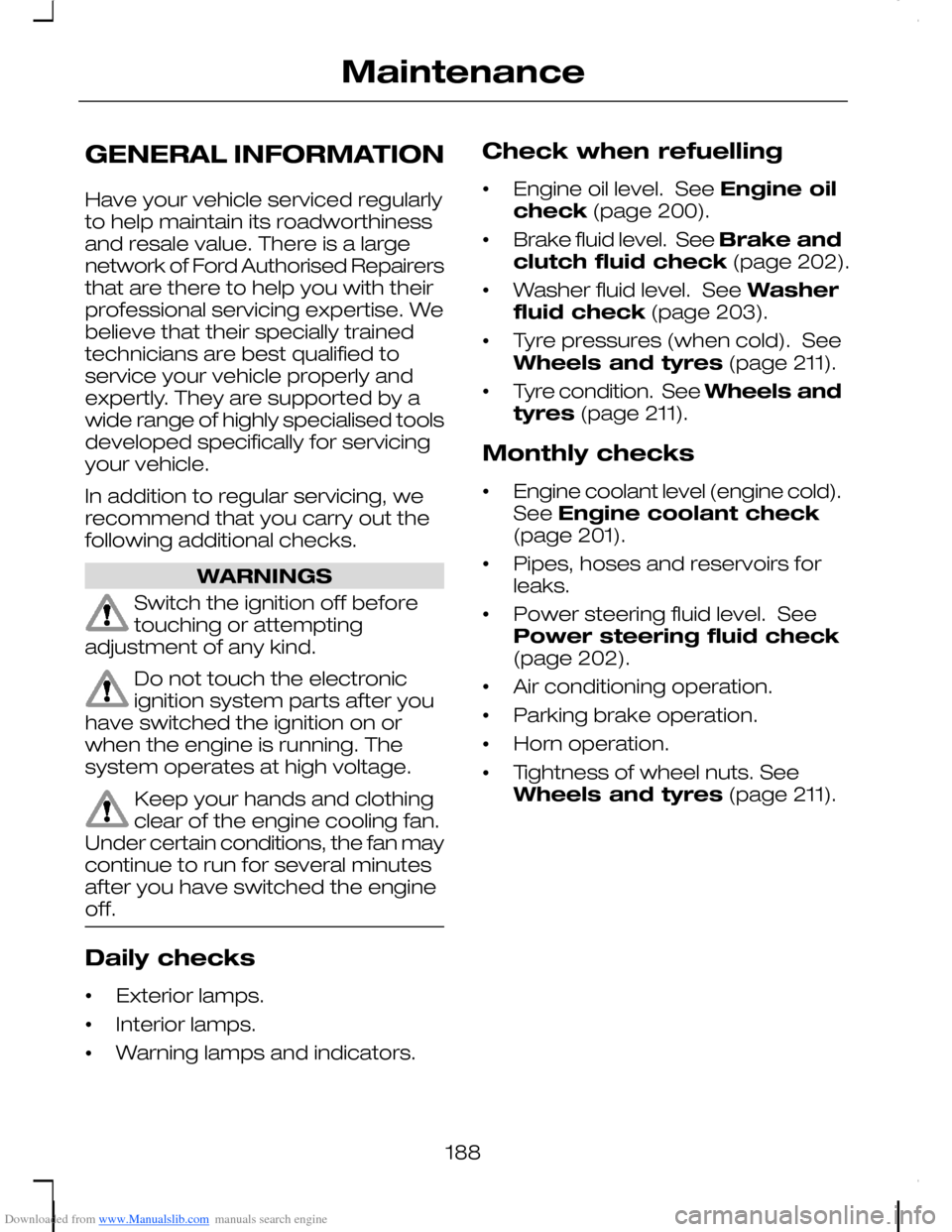
Downloaded from www.Manualslib.com manuals search engine GENERAL INFORMATION
Have your vehicle serviced regularlyto help maintain its roadworthinessand resale value. There is a largenetwork of Ford Authorised Repairersthat are there to help you with theirprofessional servicing expertise. Webelieve that their specially trainedtechnicians are best qualified toservice your vehicle properly andexpertly. They are supported by awide range of highly specialised toolsdeveloped specifically for servicingyour vehicle.
In addition to regular servicing, werecommend that you carry out thefollowing additional checks.
WARNINGS
Switch the ignition off beforetouching or attemptingadjustment of any kind.
Do not touch the electronicignition system parts after youhave switched the ignition on orwhen the engine is running. Thesystem operates at high voltage.
Keep your hands and clothingclear of the engine cooling fan.Under certain conditions, the fan maycontinue to run for several minutesafter you have switched the engineoff.
Daily checks
•Exterior lamps.
•Interior lamps.
•Warning lamps and indicators.
Check when refuelling
•Engine oil level. See Engine oilcheck (page 200).
•Brake fluid level. See Brake andclutch fluid check (page 202).
•Washer fluid level. See Washerfluid check (page 203).
•Tyre pressures (when cold). SeeWheels and tyres (page 211).
•Tyre condition. See Wheels andtyres (page 211).
Monthly checks
•Engine coolant level (engine cold).See Engine coolant check(page 201).
•Pipes, hoses and reservoirs forleaks.
•Power steering fluid level. SeePower steering fluid check(page 202).
•Air conditioning operation.
•Parking brake operation.
•Horn operation.
•Tightness of wheel nuts. SeeWheels and tyres (page 211).
188
Maintenance
Page 192 of 278
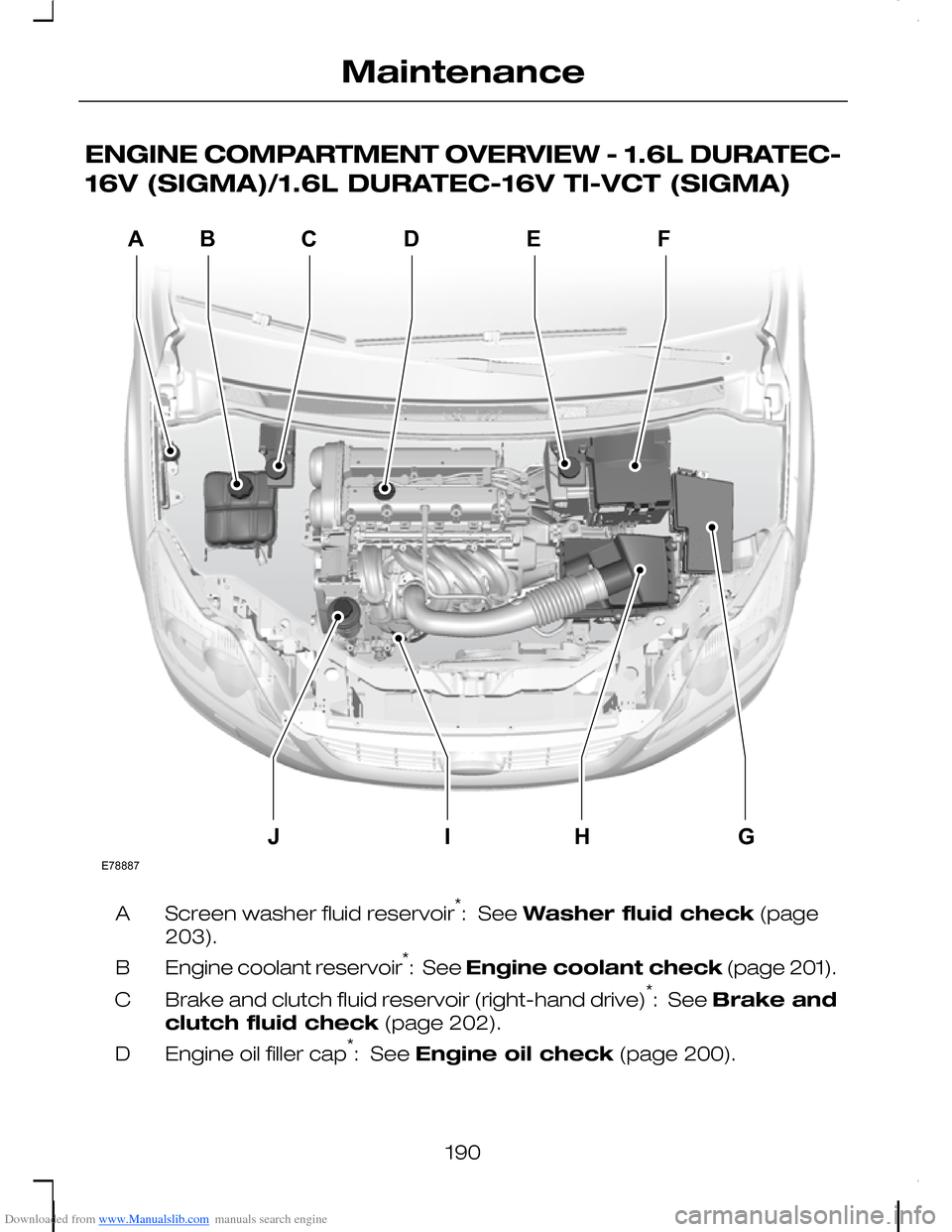
Downloaded from www.Manualslib.com manuals search engine ENGINE COMPARTMENT OVERVIEW - 1.6L DURATEC-
16V (SIGMA)/1.6L DURATEC-16V TI-VCT (SIGMA)
Screen washer fluid reservoir*: See Washer fluid check (page
203).
A
Engine coolant reservoir*: See Engine coolant check (page 201).B
Brake and clutch fluid reservoir (right-hand drive)*: See Brake and
clutch fluid check (page 202).
C
Engine oil filler cap*: See Engine oil check (page 200).D
190
MaintenanceIJFEDCBAHGE78887